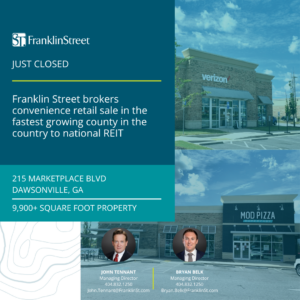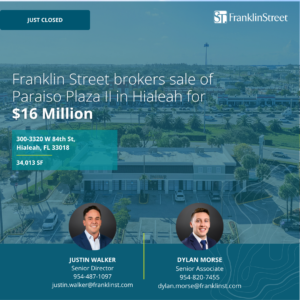Real estate brokerage Franklin Street is on the move — and the latest data on South Florida office space suggest it’s not alone.
When the lease on its 2,500-square-foot office in Plantation expires in December, Franklin intends to double or nearly triple its space to accommodate up to 100 employees. Its brokers are at work ferreting out 6,000 square feet of Class A space for the company whose primary business is trading investment-quality real estate.
“That’s happening throughout Broward” County, said Greg Matus, the brokerage’s regional managing partner for South Florida. “A lot of people are looking to get into premium space and solidify long-term deals.”
Across the region last year, tenants relocated across hundreds of thousands of square feet of offices as developers, who had mostly focused on residential projects in the rebounding economy, delivered limited new office options.
In Broward County, the office market finished 2015 with 763,691 square feet of net absorption, primarily by software publishers, insurance carriers, legal services and business support firms, according to data from CBRE Inc.
Tenants in Palm Beach County leased 1.7 million square feet last year, a 38 percent increase over 2014, for 419,888 square feet of net absorption driven by organic growth as companies moved to “right size” their staff after downsizing, Cushman & Wakefield of Florida Inc. reported in its quarterly office snapshot.
In Miami-Dade County, net absorption neared 1.2 million square feet in 2015, nearly triple the previous year’s tally of 441,367 square feet.
The desire for higher quality space fueled rising rents in most markets where limited supply, especially for larger tenants, shifted the markets in favor of landlords.
“It’s great news for owners; tougher news for tenants who have fewer options and less negotiating leverage,” Cushman & Wakefield director Mark Pateman said.
Developers Reluctant
Construction forecasts suggest the trend is likely to continue well into 2016.
In Broward, Cushman & Wakefield reported developers “remained reluctant to break ground on office inventory,” delivering only one project in the fourth quarter: Pembroke Pointe, Duke Realty’s 143,535-square-foot Class A building in the southwest Broward submarket.
“We’re starting to see the potential of new construction that we haven’t seen in many years,” Cushman & Wakefield executive director Deanna Lobinsky said.
But for now, most new construction still focus on multifamily, industrial and retail, pushing up development costs and making new office space a less feasible option.
Nowhere in the region is the preference for other asset types more noticeable than in Palm Beach County, where no new office projects have been built since 2011. None were under construction by the end of 2015, according to Cushman, despite a push by some city governments to encourage new Class A projects.
Trophy assets remain in high demand by investors as price leaders like Phillips Point, Esperante Corporate Center and CityPlace tower — a 2008 development that was the first Class A office tower built in West Palm Beach in more than 20 years — remain at about 95 percent occupancy.
“The buildings are actually full, and space is really tight,” Pateman said. “There are still blocks of space in creative-class spaces, but it’s getting harder and harder to accommodate the class of clients we’re seeing.”
In West Palm Beach, a city moving to create a financial district to attract wealth managers looking to escape state taxes in other parts of the U.S., the biggest need is for new premium office space for small tenants used to paying high rents for prime finishes, concierge services and other amenities.
The good news for landlords: Palm Beach County rents climbed 5.3 percent to about $37.45 per square foot for premium space as vacancies dipped and occupancy tightened to about 90 percent in most buildings in core markets, Cushman reported.
Brokers like Pateman hope this velocity will encourage new projects, especially with major infrastructure investments like All Aboard Florida’s Brightline passenger rail service under construction in all three South Florida markets.
But that could take time.
“We’re going to see a slowdown in leasing, not because there’s lack of demand but because of lack of supply,” Pateman said.
That lack of supply prompted some office users to take action.
“One of the things our brokers noticed is tenants wanting to build their own space instead of leasing,” Cushman & Wakefield senior research analyst Valerie Tatum said.
One such tenant, 3Z Telecom, leases about 4,000 square feet in Miramar and purchased land to build a 34,000-square-foot owner-occupied office building as its new headquarters.
The telecom company operates in a submarket where vacancy shrank to 9.3 percent in 2015 from 10.9 percent a year earlier — on total inventory of 1.9 million square feet.
As vacancy dipped, average asking rents moved in the opposite direction, climbing to $29.67 per square foot last year from $27.72 in 2014.
“Now with Class A space limited and rents going up, Class B is starting to push their rents too because they can,” Tatum said.
New Opportunities
Meanwhile in Miami, investors are fueling the region’s most active construction pipeline.
Developers are on track to deliver 600,000 square feet of office space this year, primarily in projects offering less than 100,000 square feet, according to Marcus & Millichap Real Estate Investment Services broker Alex Zylberglait. They on schedule to complete another 412,000 square feet in 2017.
CBRE’s count put the projected development for 2017 to 2019 at about 3.3 million square feet of office space.
But Zylberglait said the new projects won’t satisfy escalating demand, resulting in private capital investors redeveloping and repositioning infill properties, including several in the Biscayne corridor.
Older buildings in Miami’s central business district have been among the key beneficiaries, attracting attention from both developers and renters drawn by rental rates sometimes about 50 percent below those of neighboring high-rises in Brickell’s financial district.
One investor, Moshe Mana, has been especially active, accumulating more than 30 downtown infill sites as part of an undisclosed investment strategy.
“It’s an area in transformation,” Marcus & Millichap senior vice president Douglas Mandel said of the central business district. “It hadn’t been heavy on trade from an investor perspective, but now we’re seeing some real velocity. The focus and attention had been on Brickell, but now we’re starting to see some larger transactions taking place downtown.”
In February, Mandel helped broker the $33.85 million sale of a renovated Miami office building at 200 SE First St. The property last sold for $21 million in a foreclosure sale in May 2014. Less than two years later, seller Integra Investments made a gain of more than 61 percent in a deal that brought new capital to the market. Mandel said the buyer, a fund linked to New York-based private equity investor Brickman, was a first-time Miami investor.
“We’re seeing continued, really great appetite for product in South Florida,” Blanca Commercial Real Estate CEO Tere Blanca said. “We’ve had tremendous new-to-market activity in the last five years. It’s become so significant that it’s worth noting.”
Improved Trajectory
Analysts say the office forecast is positive across South Florida with employment growth buoying occupancy and rental rates.
Broward added more than 27,000 jobs last year, including 11,700 white-collar positions in professional and business services.
Palm Beach County’s efforts to attract financial services firms appeared to be paying off. Its unemployment rate dipped 60 basis points to end the year at 4.9 percent, with business and financial services, information technology, aviation and manufacturing among the top industries driving expansion.
In Miami-Dade, the employment rate strengthened 1.6 percent with the majority of new hires in hospitality, trade and education.
Job growth helped push Florida’s net absorption of office space to nearly 6.5 million square feet in 2015 — about 3.8 million more than the previous year, CBRE reported.
South Florida submarkets like Kendall and Coral Gables joined Aventura, Miami Beach and Miami’s Coconut Grove with single-digit vacancies in 2015. And in the fourth quarter, Miami-Dade office tenants executed 132 leases for 615,000 square feet.
Of 156,407 square feet of net absorption in Palm Beach County, about 68 percent was in Boca Raton. Technology firms and legal and financial services accounted for 39 percent of that activity, according to CBRE.
In Broward, leasing activity was concentrated in suburban submarkets like Plantation, where one tenant, Magic Leap, signed a 256,737-square-foot lease in a former Motorola building on West Sunrise Boulevard.
But brokers in submarkets with concentrations of lower quality buildings say big transactions aren’t as likely.
In Cypress Creek, for instance, asking rents fell in the last year as vacancy rose. Much of that submarket’s 4 million square feet is Class B or C space. For triple net leases, which include taxes, insurance and maintenance costs with the base rent, average asking rents were $23.46 per square foot, down from $24.44. And overall vacancy rose to 14.7 percent in 2015, up from 12.3 percent a year earlier.
“We have a lot of competition in that product-type up here,” Sperry Van Ness president and CEO Keith Kidwell said. “A lot of the tenants have upgraded to nicer space.”
Kidwell, a 25-year Broward broker, said he fielded dozens of calls after a client bought the nearly 70,000-square-foot vacant building at 2200 W. Commercial Blvd. and started a million-dollar upgrade to increase rental rates and attract new tenants.
“That office market is still soft, and we continued to be approached by owner-users looking to purchase the property for their own use,” he said.
For tenants on the move like Franklin Street, the competition is fierce for premium space.
“Because there are limited options, tenants aren’t necessarily going to have a lot of options,” Lobinsky said. “They’re going to have to make a decision on product type or size of space.”



